Project Proposal: EMR Implementation at ISS Hospital, Uganda
VerifiedAdded on 2023/01/17
|28
|8342
|93
Project
AI Summary
This project proposal details the implementation of an Electronic Medical Record (EMR) system at the ISS Hospital in Mbarara, Uganda, aiming to improve patient data management and healthcare delivery. The proposal begins with an executive summary highlighting the critical need for technological advancements in healthcare within developing countries like Uganda, particularly given the challenges posed by HIV/AIDS. It outlines the background and rationale, emphasizing the context of the ISS clinic, founded to provide compassionate care to HIV-positive patients. The project goals include establishing a feasible EMR system, a financial plan, and a technical implementation plan. The methodology involves both primary and secondary quantitative data collection, including a literature review and data analysis. The proposal includes a detailed timeline, ethical considerations, and an evaluation framework. It also identifies key stakeholders, the project budget, and a stakeholder management plan to ensure the project's success. The proposal underscores the importance of EMR systems for managing patient data, improving healthcare outcomes, and addressing the high death rates in Uganda.
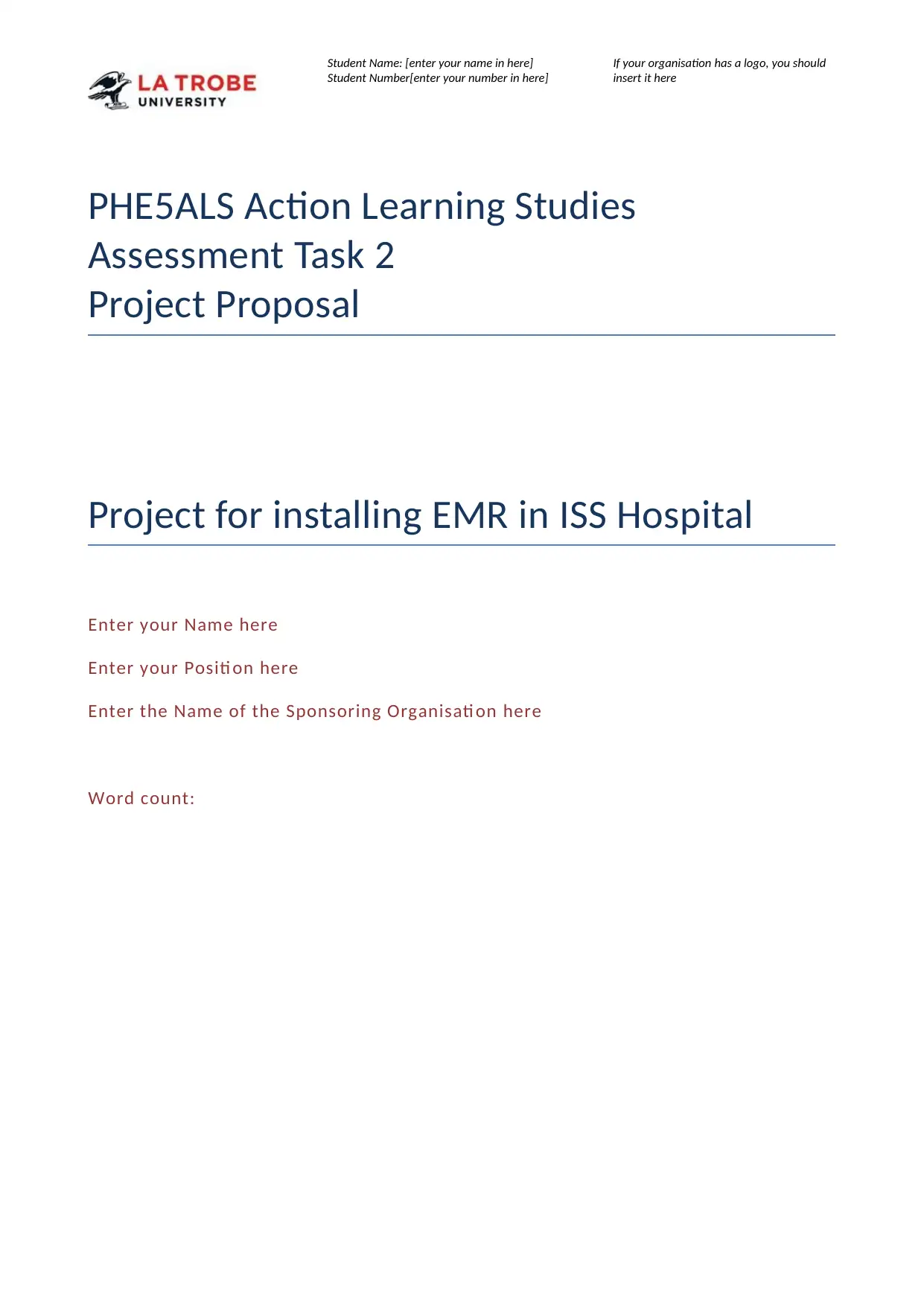
Student Name: [enter your name in here]
Student Number[enter your number in here]
If your organisation has a logo, you should
insert it here
PHE5ALS Action Learning Studies
Assessment Task 2
Project Proposal
Project for installing EMR in ISS Hospital
Enter your Name here
Enter your Positi on here
Enter the Name of the Sponsoring Organisati on here
Word count:
Student Number[enter your number in here]
If your organisation has a logo, you should
insert it here
PHE5ALS Action Learning Studies
Assessment Task 2
Project Proposal
Project for installing EMR in ISS Hospital
Enter your Name here
Enter your Positi on here
Enter the Name of the Sponsoring Organisati on here
Word count:
Paraphrase This Document
Need a fresh take? Get an instant paraphrase of this document with our AI Paraphraser
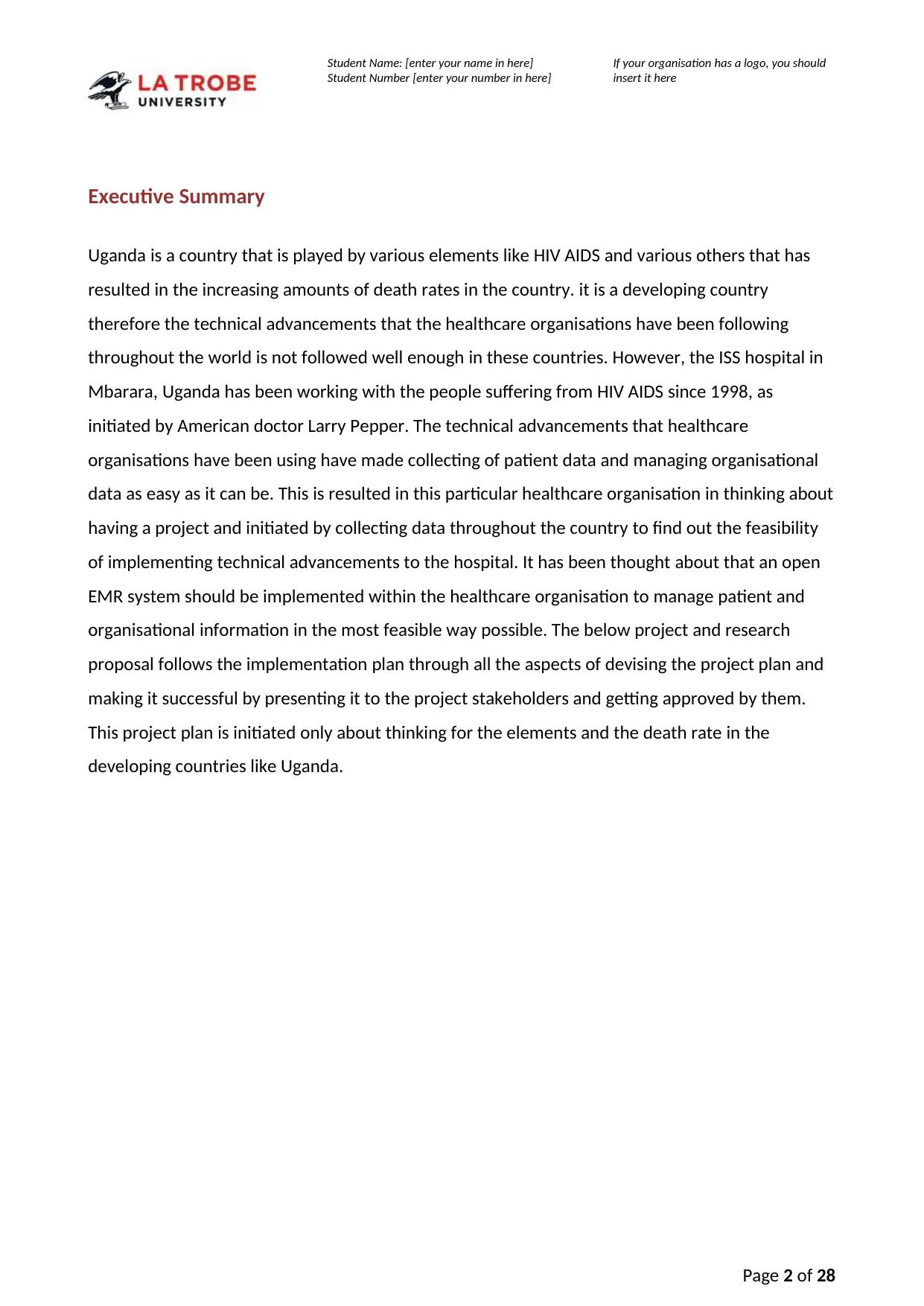
Student Name: [enter your name in here]
Student Number [enter your number in here]
If your organisation has a logo, you should
insert it here
Executive Summary
Uganda is a country that is played by various elements like HIV AIDS and various others that has
resulted in the increasing amounts of death rates in the country. it is a developing country
therefore the technical advancements that the healthcare organisations have been following
throughout the world is not followed well enough in these countries. However, the ISS hospital in
Mbarara, Uganda has been working with the people suffering from HIV AIDS since 1998, as
initiated by American doctor Larry Pepper. The technical advancements that healthcare
organisations have been using have made collecting of patient data and managing organisational
data as easy as it can be. This is resulted in this particular healthcare organisation in thinking about
having a project and initiated by collecting data throughout the country to find out the feasibility
of implementing technical advancements to the hospital. It has been thought about that an open
EMR system should be implemented within the healthcare organisation to manage patient and
organisational information in the most feasible way possible. The below project and research
proposal follows the implementation plan through all the aspects of devising the project plan and
making it successful by presenting it to the project stakeholders and getting approved by them.
This project plan is initiated only about thinking for the elements and the death rate in the
developing countries like Uganda.
Page 2 of 28
Student Number [enter your number in here]
If your organisation has a logo, you should
insert it here
Executive Summary
Uganda is a country that is played by various elements like HIV AIDS and various others that has
resulted in the increasing amounts of death rates in the country. it is a developing country
therefore the technical advancements that the healthcare organisations have been following
throughout the world is not followed well enough in these countries. However, the ISS hospital in
Mbarara, Uganda has been working with the people suffering from HIV AIDS since 1998, as
initiated by American doctor Larry Pepper. The technical advancements that healthcare
organisations have been using have made collecting of patient data and managing organisational
data as easy as it can be. This is resulted in this particular healthcare organisation in thinking about
having a project and initiated by collecting data throughout the country to find out the feasibility
of implementing technical advancements to the hospital. It has been thought about that an open
EMR system should be implemented within the healthcare organisation to manage patient and
organisational information in the most feasible way possible. The below project and research
proposal follows the implementation plan through all the aspects of devising the project plan and
making it successful by presenting it to the project stakeholders and getting approved by them.
This project plan is initiated only about thinking for the elements and the death rate in the
developing countries like Uganda.
Page 2 of 28
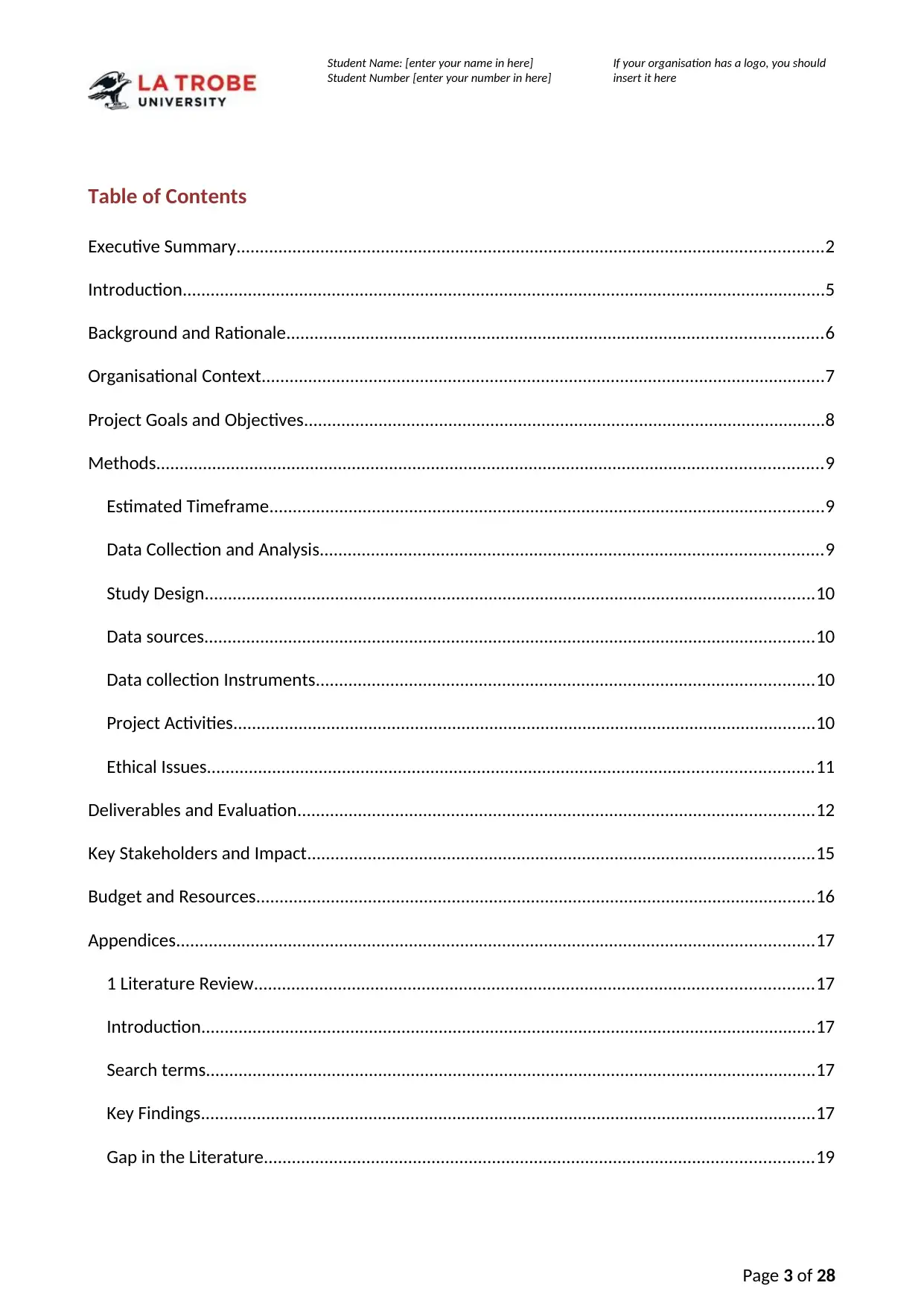
Student Name: [enter your name in here]
Student Number [enter your number in here]
If your organisation has a logo, you should
insert it here
Table of Contents
Executive Summary..............................................................................................................................2
Introduction..........................................................................................................................................5
Background and Rationale...................................................................................................................6
Organisational Context.........................................................................................................................7
Project Goals and Objectives................................................................................................................8
Methods...............................................................................................................................................9
Estimated Timeframe.......................................................................................................................9
Data Collection and Analysis............................................................................................................9
Study Design...................................................................................................................................10
Data sources...................................................................................................................................10
Data collection Instruments...........................................................................................................10
Project Activities.............................................................................................................................10
Ethical Issues..................................................................................................................................11
Deliverables and Evaluation...............................................................................................................12
Key Stakeholders and Impact.............................................................................................................15
Budget and Resources........................................................................................................................16
Appendices.........................................................................................................................................17
1 Literature Review........................................................................................................................17
Introduction....................................................................................................................................17
Search terms...................................................................................................................................17
Key Findings....................................................................................................................................17
Gap in the Literature......................................................................................................................19
Page 3 of 28
Student Number [enter your number in here]
If your organisation has a logo, you should
insert it here
Table of Contents
Executive Summary..............................................................................................................................2
Introduction..........................................................................................................................................5
Background and Rationale...................................................................................................................6
Organisational Context.........................................................................................................................7
Project Goals and Objectives................................................................................................................8
Methods...............................................................................................................................................9
Estimated Timeframe.......................................................................................................................9
Data Collection and Analysis............................................................................................................9
Study Design...................................................................................................................................10
Data sources...................................................................................................................................10
Data collection Instruments...........................................................................................................10
Project Activities.............................................................................................................................10
Ethical Issues..................................................................................................................................11
Deliverables and Evaluation...............................................................................................................12
Key Stakeholders and Impact.............................................................................................................15
Budget and Resources........................................................................................................................16
Appendices.........................................................................................................................................17
1 Literature Review........................................................................................................................17
Introduction....................................................................................................................................17
Search terms...................................................................................................................................17
Key Findings....................................................................................................................................17
Gap in the Literature......................................................................................................................19
Page 3 of 28
⊘ This is a preview!⊘
Do you want full access?
Subscribe today to unlock all pages.

Trusted by 1+ million students worldwide
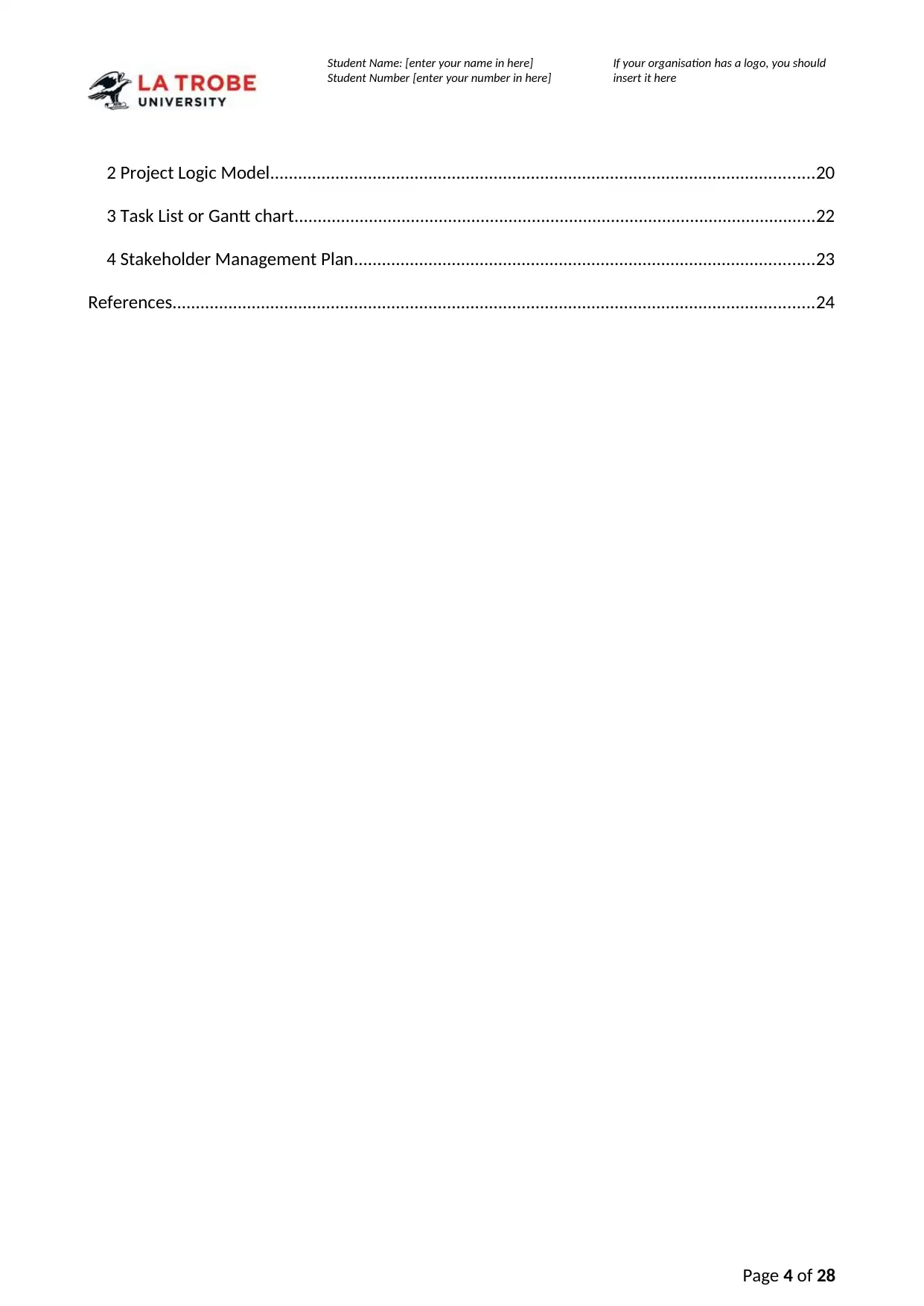
Student Name: [enter your name in here]
Student Number [enter your number in here]
If your organisation has a logo, you should
insert it here
2 Project Logic Model.....................................................................................................................20
3 Task List or Gantt chart................................................................................................................22
4 Stakeholder Management Plan...................................................................................................23
References..........................................................................................................................................24
Page 4 of 28
Student Number [enter your number in here]
If your organisation has a logo, you should
insert it here
2 Project Logic Model.....................................................................................................................20
3 Task List or Gantt chart................................................................................................................22
4 Stakeholder Management Plan...................................................................................................23
References..........................................................................................................................................24
Page 4 of 28
Paraphrase This Document
Need a fresh take? Get an instant paraphrase of this document with our AI Paraphraser
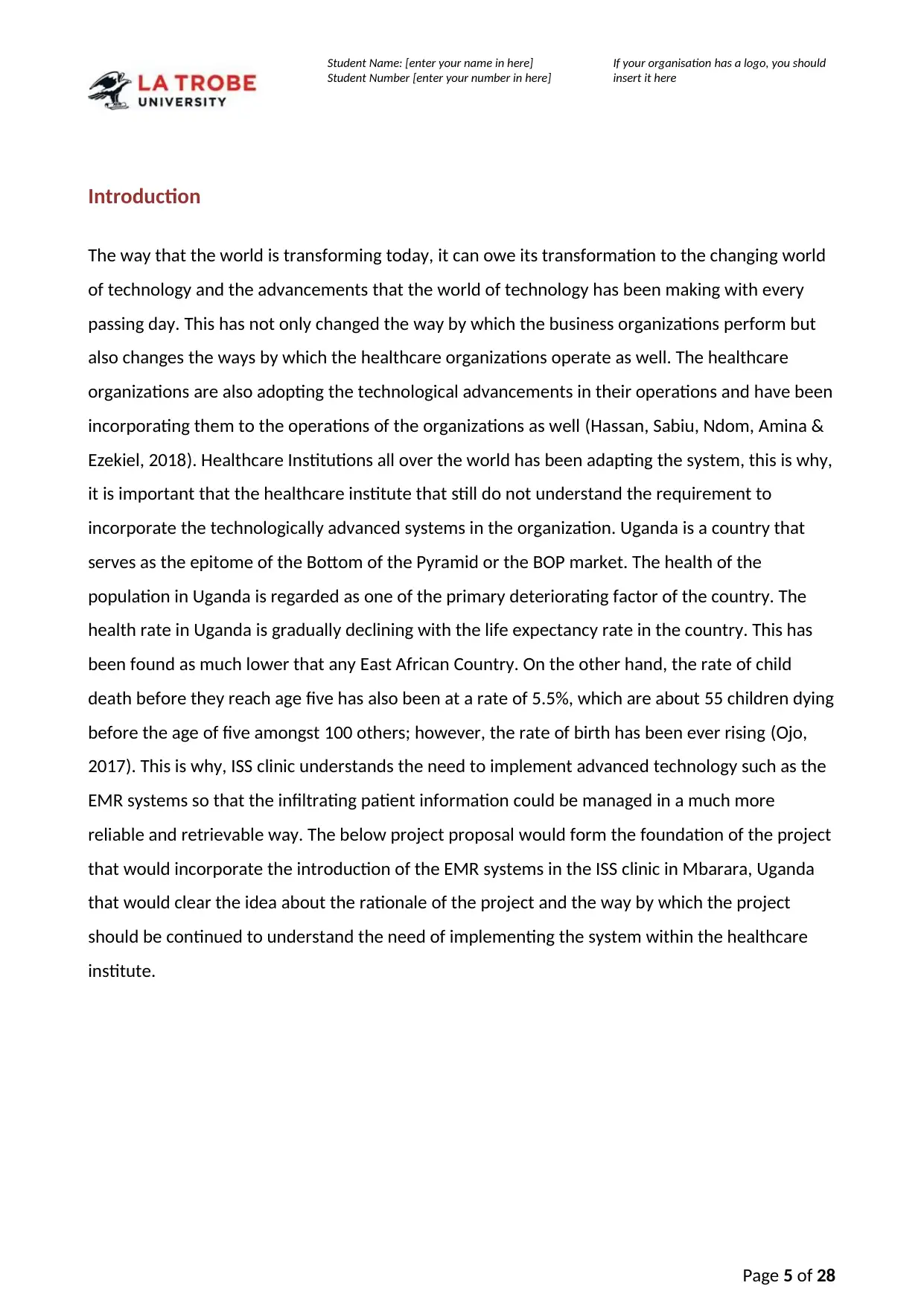
Student Name: [enter your name in here]
Student Number [enter your number in here]
If your organisation has a logo, you should
insert it here
Introduction
The way that the world is transforming today, it can owe its transformation to the changing world
of technology and the advancements that the world of technology has been making with every
passing day. This has not only changed the way by which the business organizations perform but
also changes the ways by which the healthcare organizations operate as well. The healthcare
organizations are also adopting the technological advancements in their operations and have been
incorporating them to the operations of the organizations as well (Hassan, Sabiu, Ndom, Amina &
Ezekiel, 2018). Healthcare Institutions all over the world has been adapting the system, this is why,
it is important that the healthcare institute that still do not understand the requirement to
incorporate the technologically advanced systems in the organization. Uganda is a country that
serves as the epitome of the Bottom of the Pyramid or the BOP market. The health of the
population in Uganda is regarded as one of the primary deteriorating factor of the country. The
health rate in Uganda is gradually declining with the life expectancy rate in the country. This has
been found as much lower that any East African Country. On the other hand, the rate of child
death before they reach age five has also been at a rate of 5.5%, which are about 55 children dying
before the age of five amongst 100 others; however, the rate of birth has been ever rising (Ojo,
2017). This is why, ISS clinic understands the need to implement advanced technology such as the
EMR systems so that the infiltrating patient information could be managed in a much more
reliable and retrievable way. The below project proposal would form the foundation of the project
that would incorporate the introduction of the EMR systems in the ISS clinic in Mbarara, Uganda
that would clear the idea about the rationale of the project and the way by which the project
should be continued to understand the need of implementing the system within the healthcare
institute.
Page 5 of 28
Student Number [enter your number in here]
If your organisation has a logo, you should
insert it here
Introduction
The way that the world is transforming today, it can owe its transformation to the changing world
of technology and the advancements that the world of technology has been making with every
passing day. This has not only changed the way by which the business organizations perform but
also changes the ways by which the healthcare organizations operate as well. The healthcare
organizations are also adopting the technological advancements in their operations and have been
incorporating them to the operations of the organizations as well (Hassan, Sabiu, Ndom, Amina &
Ezekiel, 2018). Healthcare Institutions all over the world has been adapting the system, this is why,
it is important that the healthcare institute that still do not understand the requirement to
incorporate the technologically advanced systems in the organization. Uganda is a country that
serves as the epitome of the Bottom of the Pyramid or the BOP market. The health of the
population in Uganda is regarded as one of the primary deteriorating factor of the country. The
health rate in Uganda is gradually declining with the life expectancy rate in the country. This has
been found as much lower that any East African Country. On the other hand, the rate of child
death before they reach age five has also been at a rate of 5.5%, which are about 55 children dying
before the age of five amongst 100 others; however, the rate of birth has been ever rising (Ojo,
2017). This is why, ISS clinic understands the need to implement advanced technology such as the
EMR systems so that the infiltrating patient information could be managed in a much more
reliable and retrievable way. The below project proposal would form the foundation of the project
that would incorporate the introduction of the EMR systems in the ISS clinic in Mbarara, Uganda
that would clear the idea about the rationale of the project and the way by which the project
should be continued to understand the need of implementing the system within the healthcare
institute.
Page 5 of 28
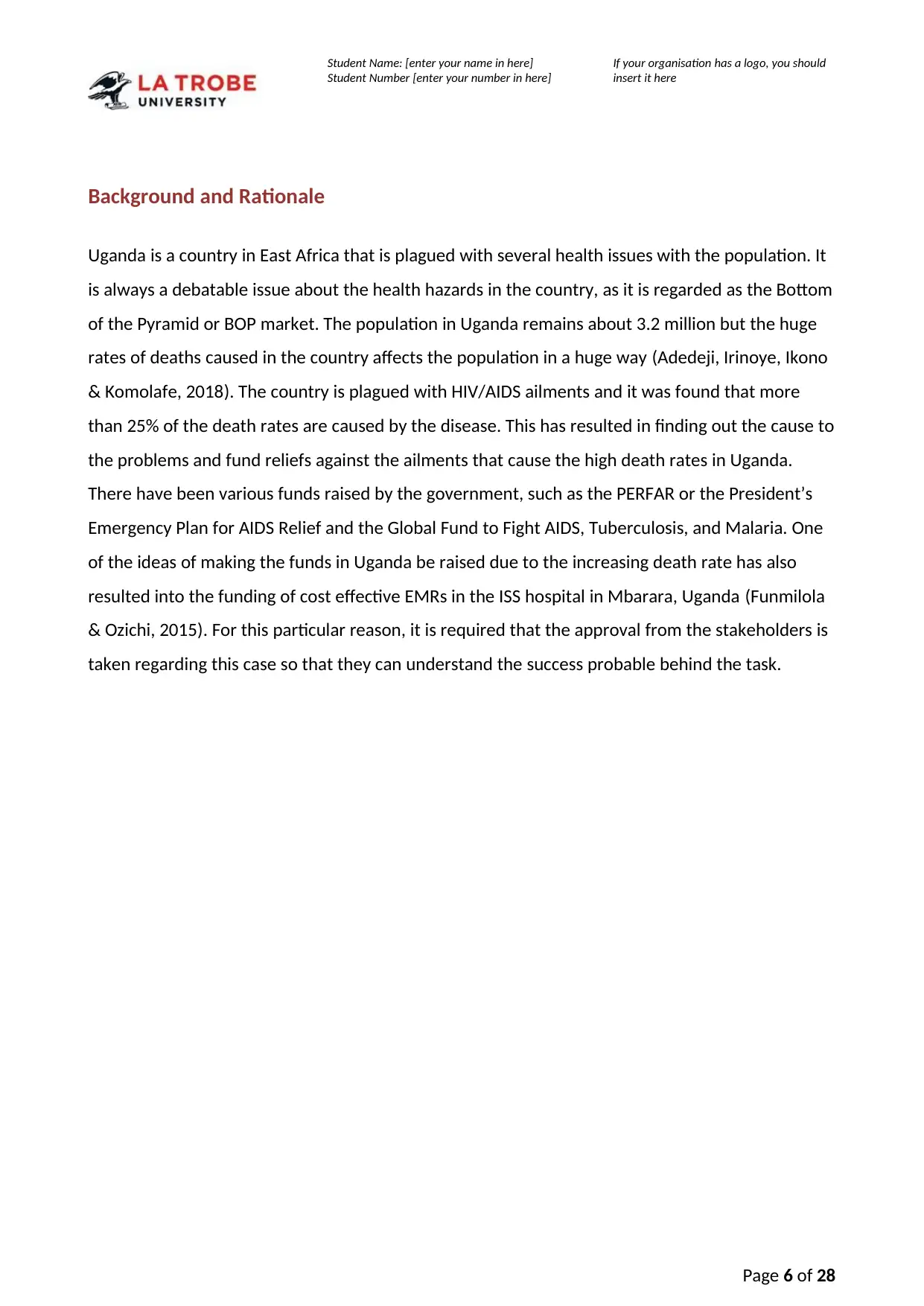
Student Name: [enter your name in here]
Student Number [enter your number in here]
If your organisation has a logo, you should
insert it here
Background and Rationale
Uganda is a country in East Africa that is plagued with several health issues with the population. It
is always a debatable issue about the health hazards in the country, as it is regarded as the Bottom
of the Pyramid or BOP market. The population in Uganda remains about 3.2 million but the huge
rates of deaths caused in the country affects the population in a huge way (Adedeji, Irinoye, Ikono
& Komolafe, 2018). The country is plagued with HIV/AIDS ailments and it was found that more
than 25% of the death rates are caused by the disease. This has resulted in finding out the cause to
the problems and fund reliefs against the ailments that cause the high death rates in Uganda.
There have been various funds raised by the government, such as the PERFAR or the President’s
Emergency Plan for AIDS Relief and the Global Fund to Fight AIDS, Tuberculosis, and Malaria. One
of the ideas of making the funds in Uganda be raised due to the increasing death rate has also
resulted into the funding of cost effective EMRs in the ISS hospital in Mbarara, Uganda (Funmilola
& Ozichi, 2015). For this particular reason, it is required that the approval from the stakeholders is
taken regarding this case so that they can understand the success probable behind the task.
Page 6 of 28
Student Number [enter your number in here]
If your organisation has a logo, you should
insert it here
Background and Rationale
Uganda is a country in East Africa that is plagued with several health issues with the population. It
is always a debatable issue about the health hazards in the country, as it is regarded as the Bottom
of the Pyramid or BOP market. The population in Uganda remains about 3.2 million but the huge
rates of deaths caused in the country affects the population in a huge way (Adedeji, Irinoye, Ikono
& Komolafe, 2018). The country is plagued with HIV/AIDS ailments and it was found that more
than 25% of the death rates are caused by the disease. This has resulted in finding out the cause to
the problems and fund reliefs against the ailments that cause the high death rates in Uganda.
There have been various funds raised by the government, such as the PERFAR or the President’s
Emergency Plan for AIDS Relief and the Global Fund to Fight AIDS, Tuberculosis, and Malaria. One
of the ideas of making the funds in Uganda be raised due to the increasing death rate has also
resulted into the funding of cost effective EMRs in the ISS hospital in Mbarara, Uganda (Funmilola
& Ozichi, 2015). For this particular reason, it is required that the approval from the stakeholders is
taken regarding this case so that they can understand the success probable behind the task.
Page 6 of 28
⊘ This is a preview!⊘
Do you want full access?
Subscribe today to unlock all pages.

Trusted by 1+ million students worldwide
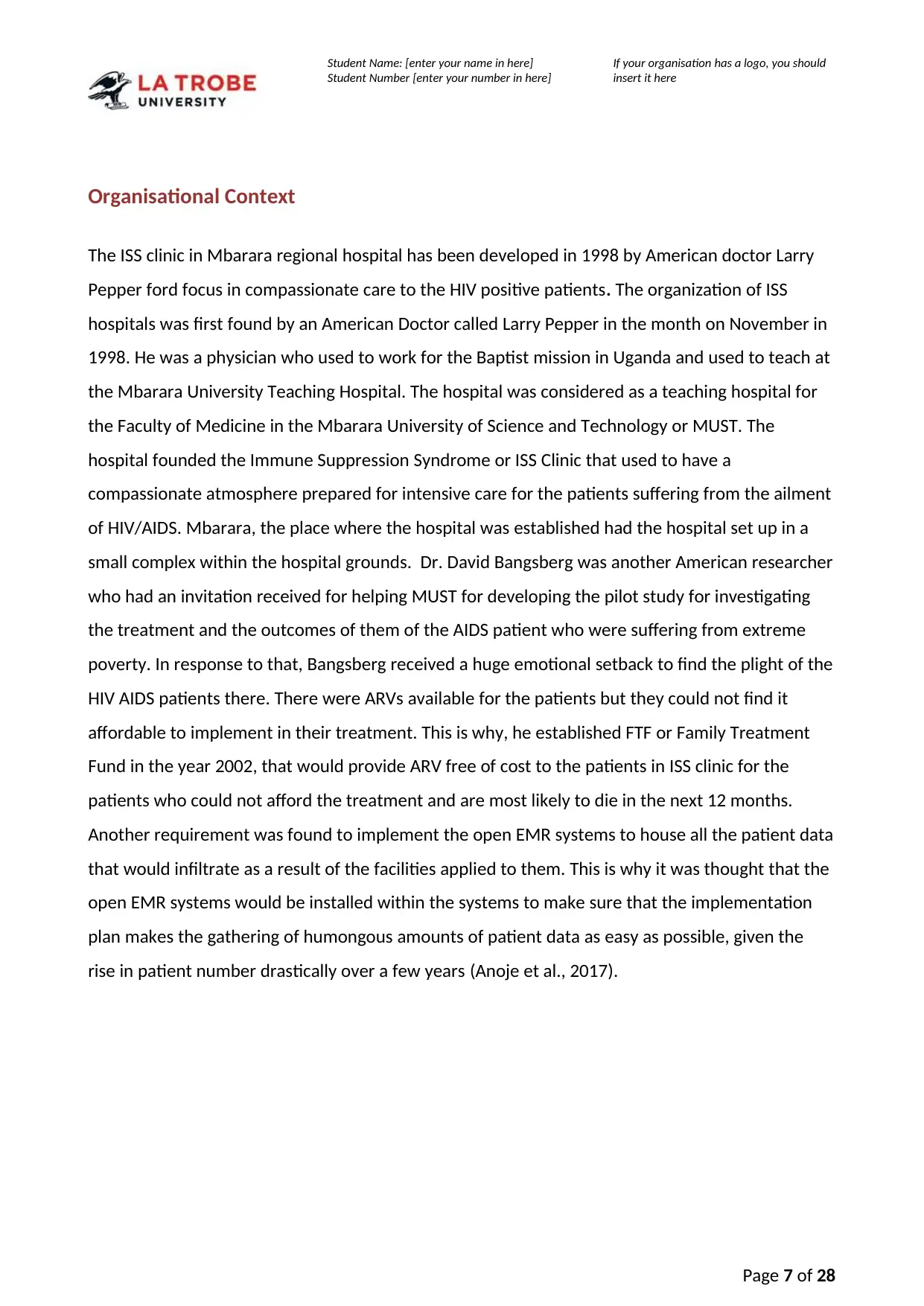
Student Name: [enter your name in here]
Student Number [enter your number in here]
If your organisation has a logo, you should
insert it here
Organisational Context
The ISS clinic in Mbarara regional hospital has been developed in 1998 by American doctor Larry
Pepper ford focus in compassionate care to the HIV positive patients. The organization of ISS
hospitals was first found by an American Doctor called Larry Pepper in the month on November in
1998. He was a physician who used to work for the Baptist mission in Uganda and used to teach at
the Mbarara University Teaching Hospital. The hospital was considered as a teaching hospital for
the Faculty of Medicine in the Mbarara University of Science and Technology or MUST. The
hospital founded the Immune Suppression Syndrome or ISS Clinic that used to have a
compassionate atmosphere prepared for intensive care for the patients suffering from the ailment
of HIV/AIDS. Mbarara, the place where the hospital was established had the hospital set up in a
small complex within the hospital grounds. Dr. David Bangsberg was another American researcher
who had an invitation received for helping MUST for developing the pilot study for investigating
the treatment and the outcomes of them of the AIDS patient who were suffering from extreme
poverty. In response to that, Bangsberg received a huge emotional setback to find the plight of the
HIV AIDS patients there. There were ARVs available for the patients but they could not find it
affordable to implement in their treatment. This is why, he established FTF or Family Treatment
Fund in the year 2002, that would provide ARV free of cost to the patients in ISS clinic for the
patients who could not afford the treatment and are most likely to die in the next 12 months.
Another requirement was found to implement the open EMR systems to house all the patient data
that would infiltrate as a result of the facilities applied to them. This is why it was thought that the
open EMR systems would be installed within the systems to make sure that the implementation
plan makes the gathering of humongous amounts of patient data as easy as possible, given the
rise in patient number drastically over a few years (Anoje et al., 2017).
Page 7 of 28
Student Number [enter your number in here]
If your organisation has a logo, you should
insert it here
Organisational Context
The ISS clinic in Mbarara regional hospital has been developed in 1998 by American doctor Larry
Pepper ford focus in compassionate care to the HIV positive patients. The organization of ISS
hospitals was first found by an American Doctor called Larry Pepper in the month on November in
1998. He was a physician who used to work for the Baptist mission in Uganda and used to teach at
the Mbarara University Teaching Hospital. The hospital was considered as a teaching hospital for
the Faculty of Medicine in the Mbarara University of Science and Technology or MUST. The
hospital founded the Immune Suppression Syndrome or ISS Clinic that used to have a
compassionate atmosphere prepared for intensive care for the patients suffering from the ailment
of HIV/AIDS. Mbarara, the place where the hospital was established had the hospital set up in a
small complex within the hospital grounds. Dr. David Bangsberg was another American researcher
who had an invitation received for helping MUST for developing the pilot study for investigating
the treatment and the outcomes of them of the AIDS patient who were suffering from extreme
poverty. In response to that, Bangsberg received a huge emotional setback to find the plight of the
HIV AIDS patients there. There were ARVs available for the patients but they could not find it
affordable to implement in their treatment. This is why, he established FTF or Family Treatment
Fund in the year 2002, that would provide ARV free of cost to the patients in ISS clinic for the
patients who could not afford the treatment and are most likely to die in the next 12 months.
Another requirement was found to implement the open EMR systems to house all the patient data
that would infiltrate as a result of the facilities applied to them. This is why it was thought that the
open EMR systems would be installed within the systems to make sure that the implementation
plan makes the gathering of humongous amounts of patient data as easy as possible, given the
rise in patient number drastically over a few years (Anoje et al., 2017).
Page 7 of 28
Paraphrase This Document
Need a fresh take? Get an instant paraphrase of this document with our AI Paraphraser
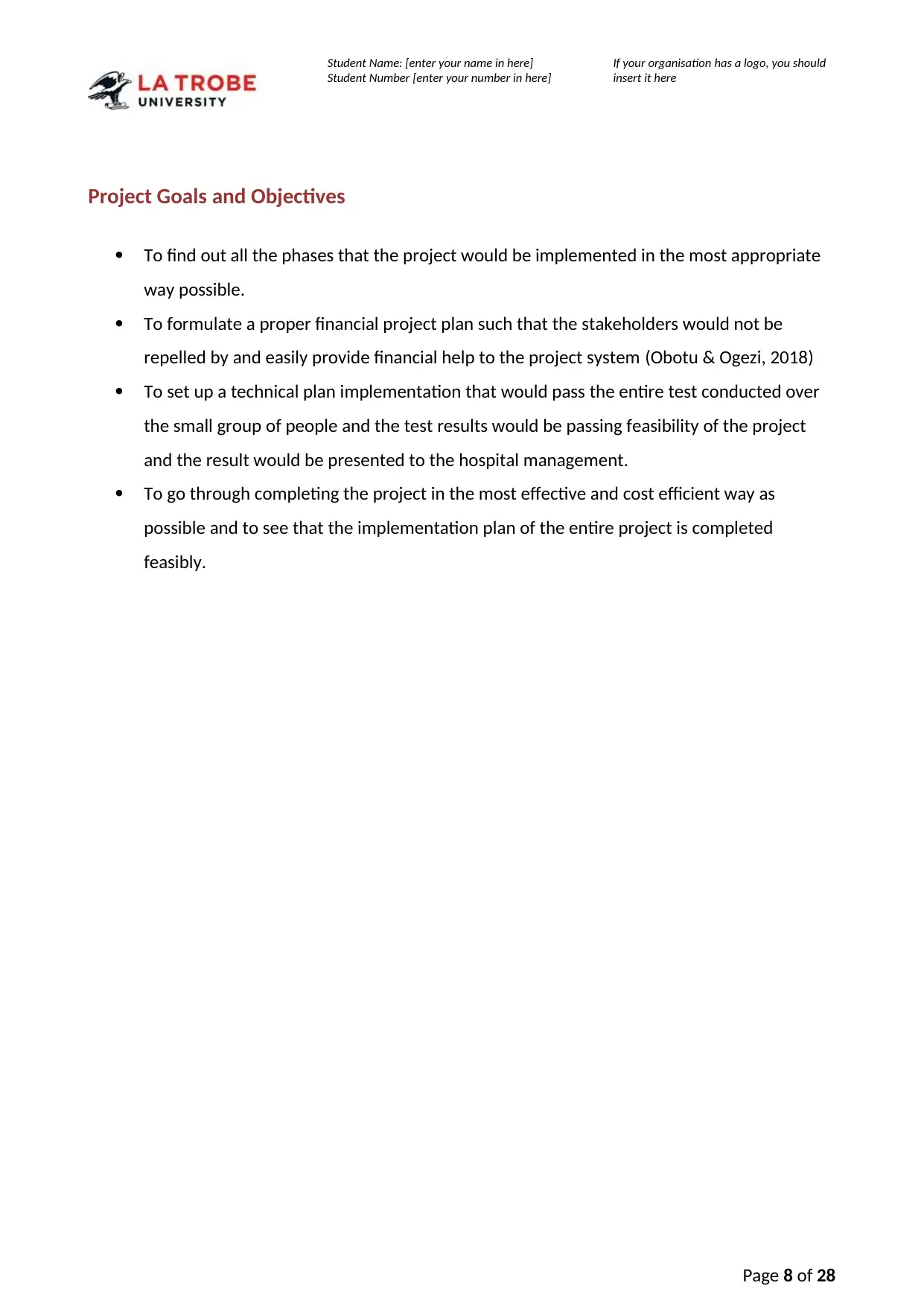
Student Name: [enter your name in here]
Student Number [enter your number in here]
If your organisation has a logo, you should
insert it here
Project Goals and Objectives
To find out all the phases that the project would be implemented in the most appropriate
way possible.
To formulate a proper financial project plan such that the stakeholders would not be
repelled by and easily provide financial help to the project system (Obotu & Ogezi, 2018)
To set up a technical plan implementation that would pass the entire test conducted over
the small group of people and the test results would be passing feasibility of the project
and the result would be presented to the hospital management.
To go through completing the project in the most effective and cost efficient way as
possible and to see that the implementation plan of the entire project is completed
feasibly.
Page 8 of 28
Student Number [enter your number in here]
If your organisation has a logo, you should
insert it here
Project Goals and Objectives
To find out all the phases that the project would be implemented in the most appropriate
way possible.
To formulate a proper financial project plan such that the stakeholders would not be
repelled by and easily provide financial help to the project system (Obotu & Ogezi, 2018)
To set up a technical plan implementation that would pass the entire test conducted over
the small group of people and the test results would be passing feasibility of the project
and the result would be presented to the hospital management.
To go through completing the project in the most effective and cost efficient way as
possible and to see that the implementation plan of the entire project is completed
feasibly.
Page 8 of 28
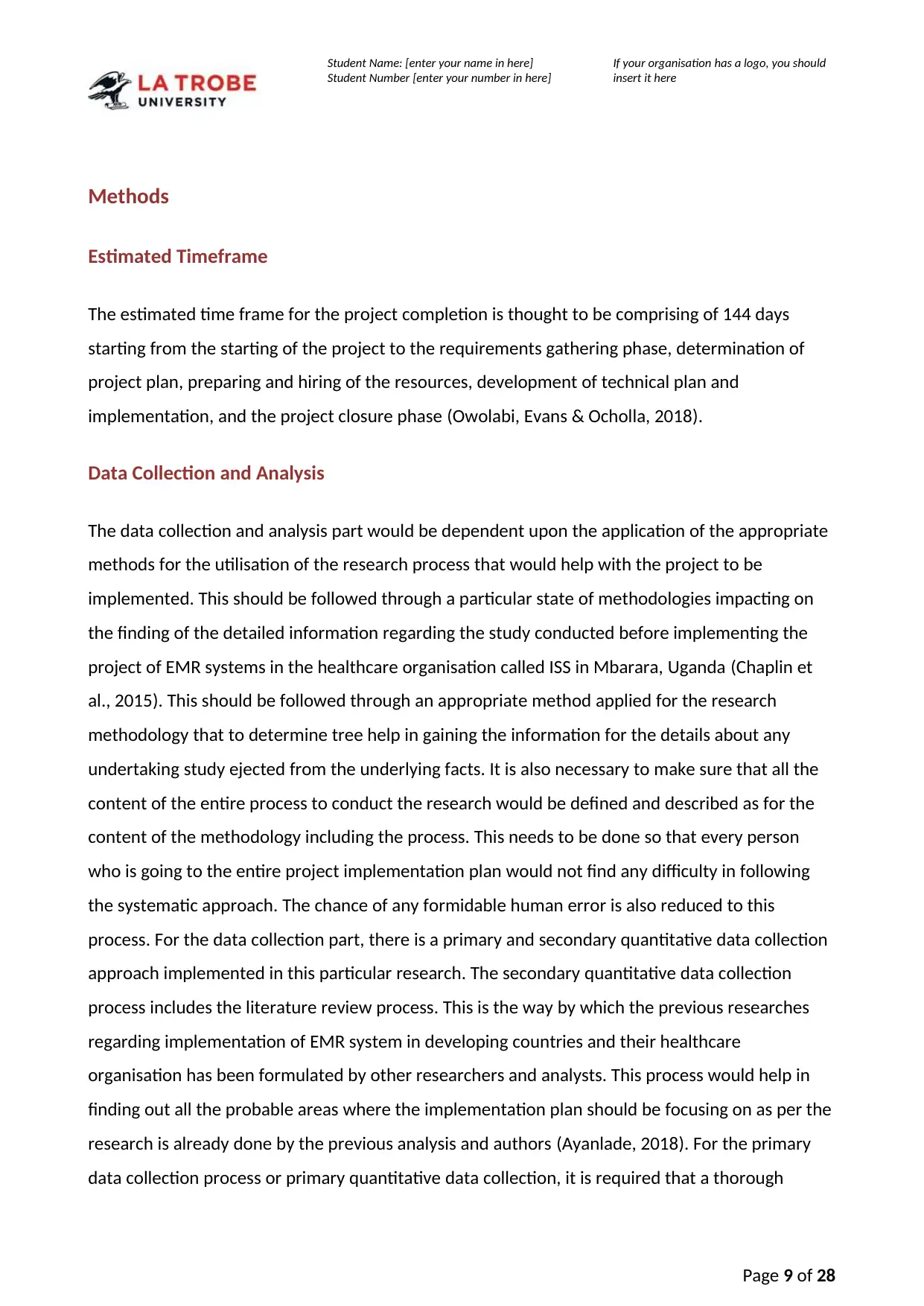
Student Name: [enter your name in here]
Student Number [enter your number in here]
If your organisation has a logo, you should
insert it here
Methods
Estimated Timeframe
The estimated time frame for the project completion is thought to be comprising of 144 days
starting from the starting of the project to the requirements gathering phase, determination of
project plan, preparing and hiring of the resources, development of technical plan and
implementation, and the project closure phase (Owolabi, Evans & Ocholla, 2018).
Data Collection and Analysis
The data collection and analysis part would be dependent upon the application of the appropriate
methods for the utilisation of the research process that would help with the project to be
implemented. This should be followed through a particular state of methodologies impacting on
the finding of the detailed information regarding the study conducted before implementing the
project of EMR systems in the healthcare organisation called ISS in Mbarara, Uganda (Chaplin et
al., 2015). This should be followed through an appropriate method applied for the research
methodology that to determine tree help in gaining the information for the details about any
undertaking study ejected from the underlying facts. It is also necessary to make sure that all the
content of the entire process to conduct the research would be defined and described as for the
content of the methodology including the process. This needs to be done so that every person
who is going to the entire project implementation plan would not find any difficulty in following
the systematic approach. The chance of any formidable human error is also reduced to this
process. For the data collection part, there is a primary and secondary quantitative data collection
approach implemented in this particular research. The secondary quantitative data collection
process includes the literature review process. This is the way by which the previous researches
regarding implementation of EMR system in developing countries and their healthcare
organisation has been formulated by other researchers and analysts. This process would help in
finding out all the probable areas where the implementation plan should be focusing on as per the
research is already done by the previous analysis and authors (Ayanlade, 2018). For the primary
data collection process or primary quantitative data collection, it is required that a thorough
Page 9 of 28
Student Number [enter your number in here]
If your organisation has a logo, you should
insert it here
Methods
Estimated Timeframe
The estimated time frame for the project completion is thought to be comprising of 144 days
starting from the starting of the project to the requirements gathering phase, determination of
project plan, preparing and hiring of the resources, development of technical plan and
implementation, and the project closure phase (Owolabi, Evans & Ocholla, 2018).
Data Collection and Analysis
The data collection and analysis part would be dependent upon the application of the appropriate
methods for the utilisation of the research process that would help with the project to be
implemented. This should be followed through a particular state of methodologies impacting on
the finding of the detailed information regarding the study conducted before implementing the
project of EMR systems in the healthcare organisation called ISS in Mbarara, Uganda (Chaplin et
al., 2015). This should be followed through an appropriate method applied for the research
methodology that to determine tree help in gaining the information for the details about any
undertaking study ejected from the underlying facts. It is also necessary to make sure that all the
content of the entire process to conduct the research would be defined and described as for the
content of the methodology including the process. This needs to be done so that every person
who is going to the entire project implementation plan would not find any difficulty in following
the systematic approach. The chance of any formidable human error is also reduced to this
process. For the data collection part, there is a primary and secondary quantitative data collection
approach implemented in this particular research. The secondary quantitative data collection
process includes the literature review process. This is the way by which the previous researches
regarding implementation of EMR system in developing countries and their healthcare
organisation has been formulated by other researchers and analysts. This process would help in
finding out all the probable areas where the implementation plan should be focusing on as per the
research is already done by the previous analysis and authors (Ayanlade, 2018). For the primary
data collection process or primary quantitative data collection, it is required that a thorough
Page 9 of 28
⊘ This is a preview!⊘
Do you want full access?
Subscribe today to unlock all pages.

Trusted by 1+ million students worldwide
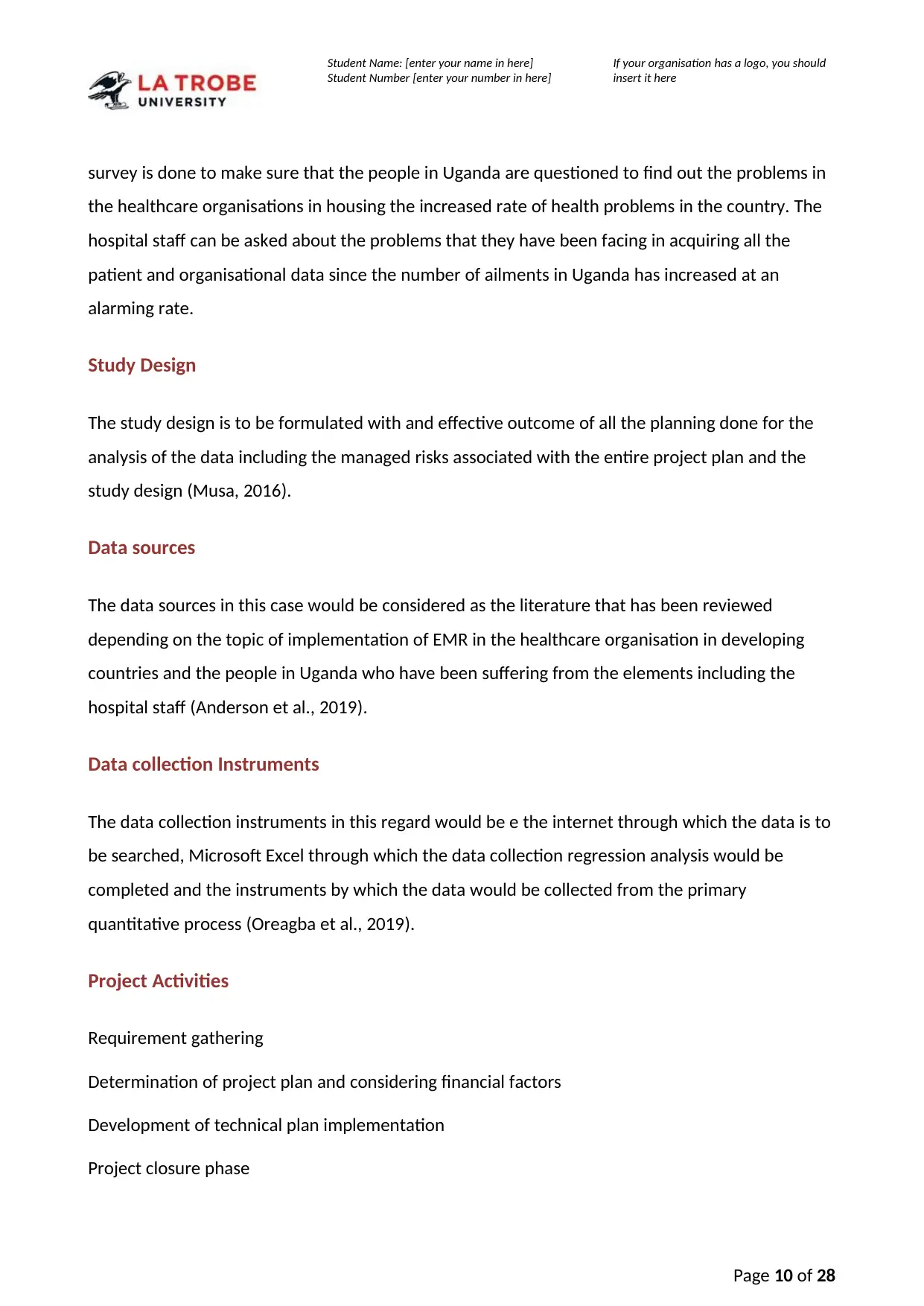
Student Name: [enter your name in here]
Student Number [enter your number in here]
If your organisation has a logo, you should
insert it here
survey is done to make sure that the people in Uganda are questioned to find out the problems in
the healthcare organisations in housing the increased rate of health problems in the country. The
hospital staff can be asked about the problems that they have been facing in acquiring all the
patient and organisational data since the number of ailments in Uganda has increased at an
alarming rate.
Study Design
The study design is to be formulated with and effective outcome of all the planning done for the
analysis of the data including the managed risks associated with the entire project plan and the
study design (Musa, 2016).
Data sources
The data sources in this case would be considered as the literature that has been reviewed
depending on the topic of implementation of EMR in the healthcare organisation in developing
countries and the people in Uganda who have been suffering from the elements including the
hospital staff (Anderson et al., 2019).
Data collection Instruments
The data collection instruments in this regard would be e the internet through which the data is to
be searched, Microsoft Excel through which the data collection regression analysis would be
completed and the instruments by which the data would be collected from the primary
quantitative process (Oreagba et al., 2019).
Project Activities
Requirement gathering
Determination of project plan and considering financial factors
Development of technical plan implementation
Project closure phase
Page 10 of 28
Student Number [enter your number in here]
If your organisation has a logo, you should
insert it here
survey is done to make sure that the people in Uganda are questioned to find out the problems in
the healthcare organisations in housing the increased rate of health problems in the country. The
hospital staff can be asked about the problems that they have been facing in acquiring all the
patient and organisational data since the number of ailments in Uganda has increased at an
alarming rate.
Study Design
The study design is to be formulated with and effective outcome of all the planning done for the
analysis of the data including the managed risks associated with the entire project plan and the
study design (Musa, 2016).
Data sources
The data sources in this case would be considered as the literature that has been reviewed
depending on the topic of implementation of EMR in the healthcare organisation in developing
countries and the people in Uganda who have been suffering from the elements including the
hospital staff (Anderson et al., 2019).
Data collection Instruments
The data collection instruments in this regard would be e the internet through which the data is to
be searched, Microsoft Excel through which the data collection regression analysis would be
completed and the instruments by which the data would be collected from the primary
quantitative process (Oreagba et al., 2019).
Project Activities
Requirement gathering
Determination of project plan and considering financial factors
Development of technical plan implementation
Project closure phase
Page 10 of 28
Paraphrase This Document
Need a fresh take? Get an instant paraphrase of this document with our AI Paraphraser
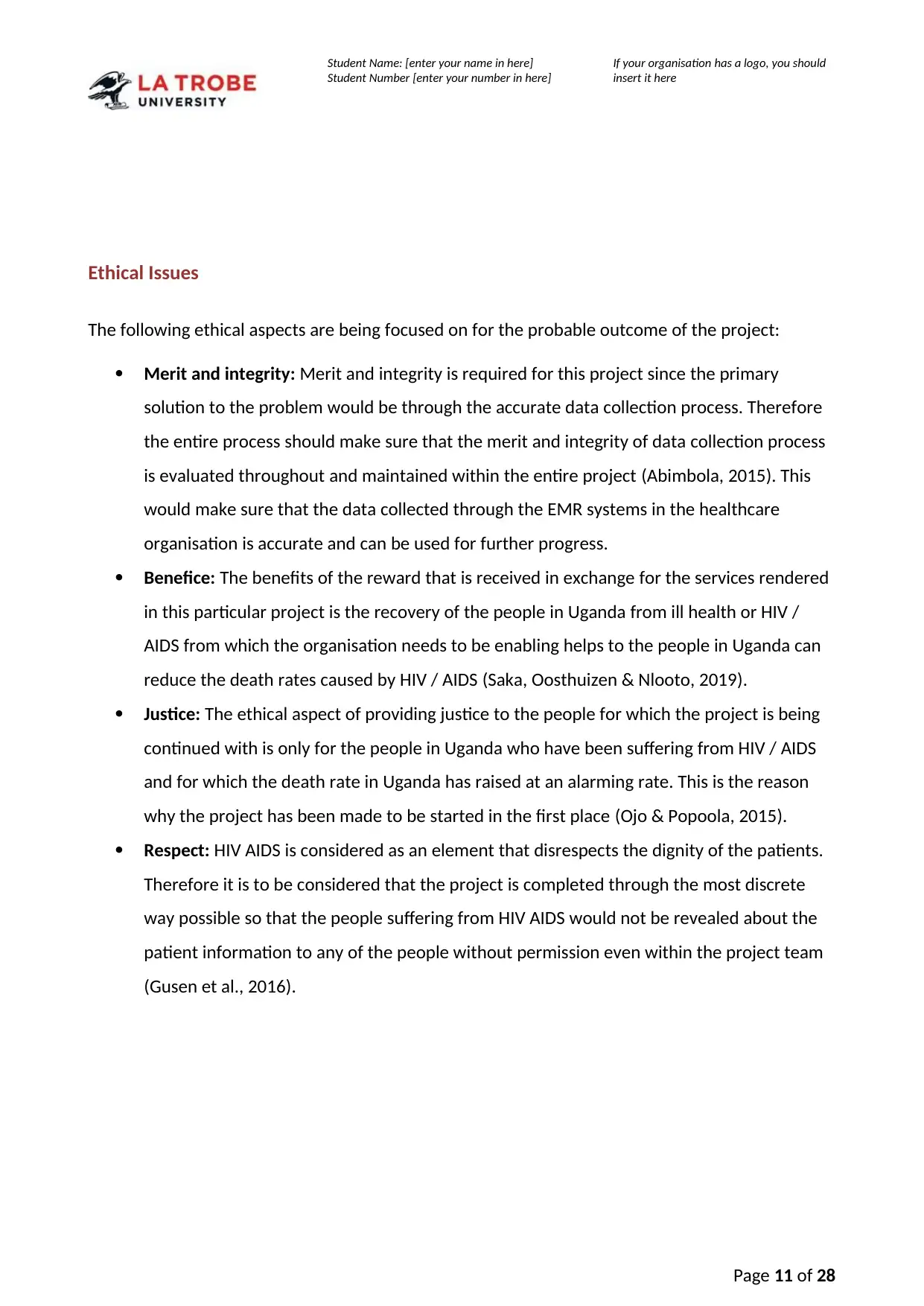
Student Name: [enter your name in here]
Student Number [enter your number in here]
If your organisation has a logo, you should
insert it here
Ethical Issues
The following ethical aspects are being focused on for the probable outcome of the project:
Merit and integrity: Merit and integrity is required for this project since the primary
solution to the problem would be through the accurate data collection process. Therefore
the entire process should make sure that the merit and integrity of data collection process
is evaluated throughout and maintained within the entire project (Abimbola, 2015). This
would make sure that the data collected through the EMR systems in the healthcare
organisation is accurate and can be used for further progress.
Benefice: The benefits of the reward that is received in exchange for the services rendered
in this particular project is the recovery of the people in Uganda from ill health or HIV /
AIDS from which the organisation needs to be enabling helps to the people in Uganda can
reduce the death rates caused by HIV / AIDS (Saka, Oosthuizen & Nlooto, 2019).
Justice: The ethical aspect of providing justice to the people for which the project is being
continued with is only for the people in Uganda who have been suffering from HIV / AIDS
and for which the death rate in Uganda has raised at an alarming rate. This is the reason
why the project has been made to be started in the first place (Ojo & Popoola, 2015).
Respect: HIV AIDS is considered as an element that disrespects the dignity of the patients.
Therefore it is to be considered that the project is completed through the most discrete
way possible so that the people suffering from HIV AIDS would not be revealed about the
patient information to any of the people without permission even within the project team
(Gusen et al., 2016).
Page 11 of 28
Student Number [enter your number in here]
If your organisation has a logo, you should
insert it here
Ethical Issues
The following ethical aspects are being focused on for the probable outcome of the project:
Merit and integrity: Merit and integrity is required for this project since the primary
solution to the problem would be through the accurate data collection process. Therefore
the entire process should make sure that the merit and integrity of data collection process
is evaluated throughout and maintained within the entire project (Abimbola, 2015). This
would make sure that the data collected through the EMR systems in the healthcare
organisation is accurate and can be used for further progress.
Benefice: The benefits of the reward that is received in exchange for the services rendered
in this particular project is the recovery of the people in Uganda from ill health or HIV /
AIDS from which the organisation needs to be enabling helps to the people in Uganda can
reduce the death rates caused by HIV / AIDS (Saka, Oosthuizen & Nlooto, 2019).
Justice: The ethical aspect of providing justice to the people for which the project is being
continued with is only for the people in Uganda who have been suffering from HIV / AIDS
and for which the death rate in Uganda has raised at an alarming rate. This is the reason
why the project has been made to be started in the first place (Ojo & Popoola, 2015).
Respect: HIV AIDS is considered as an element that disrespects the dignity of the patients.
Therefore it is to be considered that the project is completed through the most discrete
way possible so that the people suffering from HIV AIDS would not be revealed about the
patient information to any of the people without permission even within the project team
(Gusen et al., 2016).
Page 11 of 28
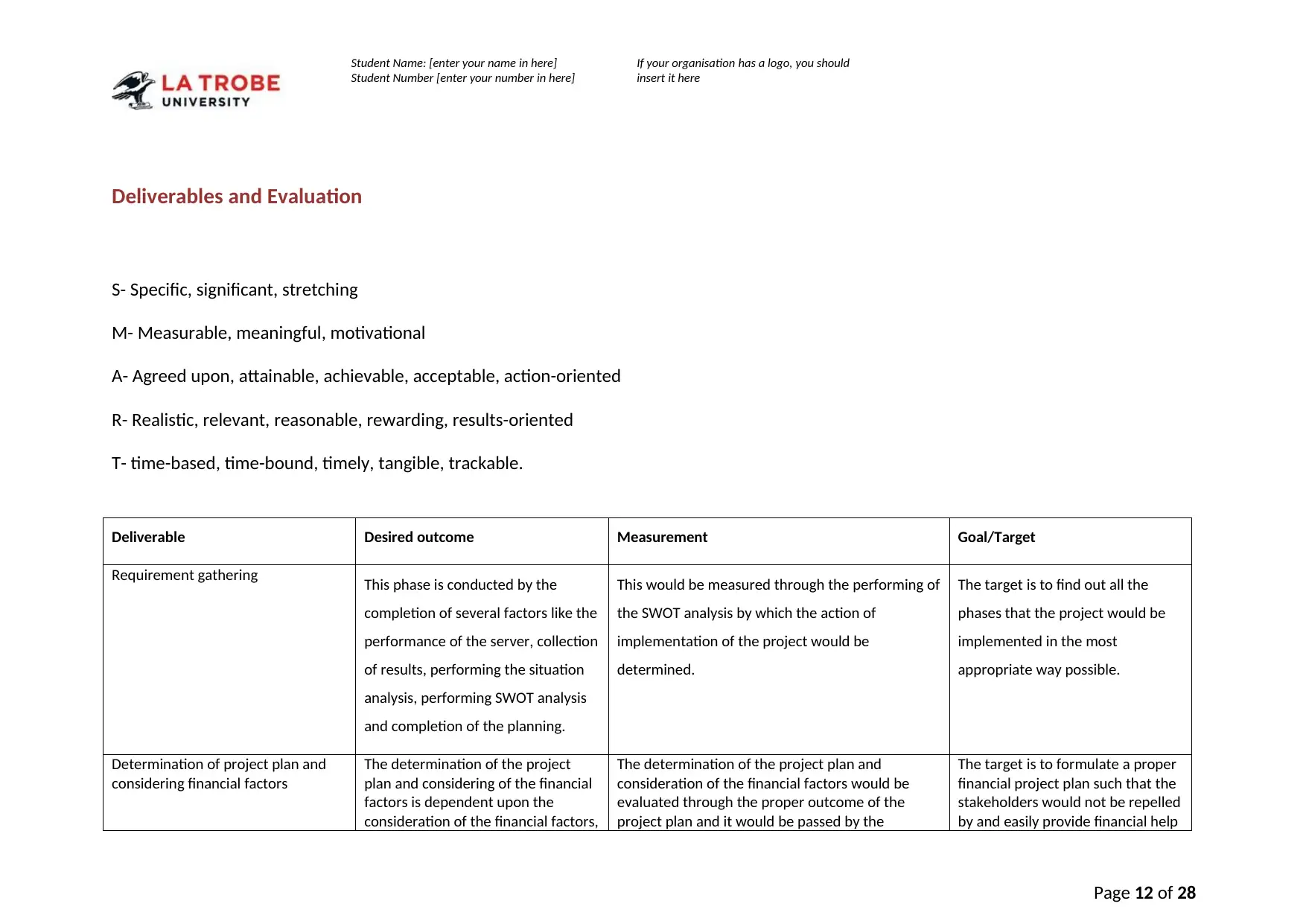
Student Name: [enter your name in here]
Student Number [enter your number in here]
If your organisation has a logo, you should
insert it here
Deliverables and Evaluation
S- Specific, significant, stretching
M- Measurable, meaningful, motivational
A- Agreed upon, attainable, achievable, acceptable, action-oriented
R- Realistic, relevant, reasonable, rewarding, results-oriented
T- time-based, time-bound, timely, tangible, trackable.
Deliverable Desired outcome Measurement Goal/Target
Requirement gathering This phase is conducted by the
completion of several factors like the
performance of the server, collection
of results, performing the situation
analysis, performing SWOT analysis
and completion of the planning.
This would be measured through the performing of
the SWOT analysis by which the action of
implementation of the project would be
determined.
The target is to find out all the
phases that the project would be
implemented in the most
appropriate way possible.
Determination of project plan and
considering financial factors
The determination of the project
plan and considering of the financial
factors is dependent upon the
consideration of the financial factors,
The determination of the project plan and
consideration of the financial factors would be
evaluated through the proper outcome of the
project plan and it would be passed by the
The target is to formulate a proper
financial project plan such that the
stakeholders would not be repelled
by and easily provide financial help
Page 12 of 28
Student Number [enter your number in here]
If your organisation has a logo, you should
insert it here
Deliverables and Evaluation
S- Specific, significant, stretching
M- Measurable, meaningful, motivational
A- Agreed upon, attainable, achievable, acceptable, action-oriented
R- Realistic, relevant, reasonable, rewarding, results-oriented
T- time-based, time-bound, timely, tangible, trackable.
Deliverable Desired outcome Measurement Goal/Target
Requirement gathering This phase is conducted by the
completion of several factors like the
performance of the server, collection
of results, performing the situation
analysis, performing SWOT analysis
and completion of the planning.
This would be measured through the performing of
the SWOT analysis by which the action of
implementation of the project would be
determined.
The target is to find out all the
phases that the project would be
implemented in the most
appropriate way possible.
Determination of project plan and
considering financial factors
The determination of the project
plan and considering of the financial
factors is dependent upon the
consideration of the financial factors,
The determination of the project plan and
consideration of the financial factors would be
evaluated through the proper outcome of the
project plan and it would be passed by the
The target is to formulate a proper
financial project plan such that the
stakeholders would not be repelled
by and easily provide financial help
Page 12 of 28
⊘ This is a preview!⊘
Do you want full access?
Subscribe today to unlock all pages.

Trusted by 1+ million students worldwide
1 out of 28
Related Documents
Your All-in-One AI-Powered Toolkit for Academic Success.
+13062052269
info@desklib.com
Available 24*7 on WhatsApp / Email
![[object Object]](/_next/static/media/star-bottom.7253800d.svg)
Unlock your academic potential
Copyright © 2020–2025 A2Z Services. All Rights Reserved. Developed and managed by ZUCOL.





